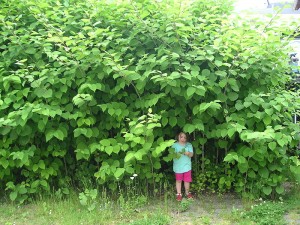Ralph and I recently spent a week in New England. On the
drive from the airport to our daughter Jenny’s home in Florence, Mass., I found
myself fixated on the colorful landscape. Although I grew up in Pennsylvania
and lived on Cape Cod for 17 years, it’s been a long time since I’ve
experienced a northern spring.
.JPG) |
| Spring in New England (photo by Jenny Boas) |
It was by happenstance that the timing of our trip
coordinated with a flush of flowering plants, but what a stroke of luck! I was
able to experience the bold bloom of forsythia bushes, the fragrant pink
blossoms of crab apple trees and prolific displays of groundcovers such as
violets, forget-me-nots and phlox. I was there to see tulips and lilies emerge
from winter-weary ground. I saw fruit trees flower, maple leaves unfurl and
everywhere I looked, I watched weeds grow at an alarming rate.
 |
| Maple leaves opened during our visit |
Dandelions, that bane of many a residential landscape, were
ubiquitous. The large yellow blooms dotted small yards and vast fields alike.
Although I’m sure many people struggle to eradicate the invasive wildflowers
from their lawns, every now and then you come across individuals who look at
dandelions and see opportunity.
 |
| Dandelions everywhere! |
On Mother’s Day, on our way back from a birding walk, Jenny
and I passed a group of children and adults gathered in a field overtaken by
the yellow-flowering plants. A photographer kneeling next to her tripod was
taking a family portrait. As we drove by, I smiled to think how treasured that
beautiful scene — a family encircled by gold — would be in years to come. The
timing was perfect. A few days later, that same field was covered with
dandelion seed heads, those feathery orbs of far-flying seeds attached to wispy
parachutes. It’s no wonder the common dandelion is… well, so common in New
England.
Another omnipresent weed that I watched emerge during the
week we spent in Florence was Polygonum cuspidatum, better known as
Japanese knotweed.
.JPG) |
| Knotweeds emerging alongside a daylily |
When Jenny and her husband Brett bought their house last
year, their entire eastern border was covered in dense stands of towering
knotweed. My husband worked hard last October to chop down and dig up the
aggressive perennial but, despite his valiant efforts, new plants began poking
through the ground this spring shortly after we arrived. By the time we left
seven days later, numerous shoots were already leafing out, three-feet tall and
growing taller.
 |
| If left alone, this is what knotweed can look like (photo by eattheinvaders.org) |
As I watched the knotweed surge madly skyward, I couldn’t
help but feel glad it doesn’t grow in Florida. I had the same thought as I
noticed all the tiny maple trees popping up in garden beds and onion grass
invading lawns.
Experiencing springtime in New England was a fortuitous
bonus for a pair of grandparents whose trip was planned around spending time
with family. I enjoyed taking walks in the cooler air, seeing daffodils and
watching lilacs develop. I loved the color of ornamental quince flowers — a
reddish, coral I’ve rarely seen in nature — and finding mounds of swamp cabbage
in wetlands.
.JPG) |
| Ornamental quince |
But mostly I found myself feeling grateful to be visiting only. As
much as I enjoyed a week-long taste of a northern spring, I was eager to return
home to the ever-changing southern seasons I have come to love so much.
When we told one New Englander we lived in Florida, his
response was, “What’s it like there now, 130-degrees?”
Florida may not be everyone’s idea of paradise, but it’s
mine. Although we were away for just short time, it sure is good to be home.


No comments:
Post a Comment